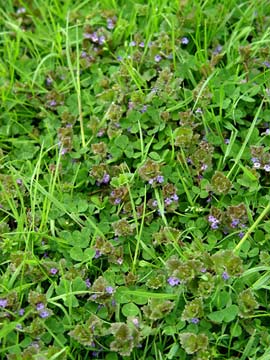Turn your back for a second, and it’s astonishing how fast weeds can gain a foothold in the lawn. From those early-spring patches of speedwell to May’s golden fields of dandelions to the fat leaves of summer plantain, Mother Nature has a varied lineup to fill any bare soil.
 Weeds can quickly dominate a thin lawn.
Weeds can quickly dominate a thin lawn.
Different weeds germinate at different times throughout a growing season – including winter in much of America. Some of them come and go with each season (annuals), while others are perennial weeds that come back from their roots year to year.
Almost all of them hit peak growth in spring when the soil warms.
If you let them grow, between the annuals reseeding themselves and the perennials spreading, weeds outcompete the grass. When that happens, the solution is to level the playing field by first eliminating the invaders.
Spring is prime time to do that because that’s not only when weeds are actively growing, it’s when they’re most vulnerable to weed-killers. A well timed spring application of a granular weed-killer such as GreenView Broadleaf Weed Control plus Lawn Food with GreenSmart can clean up the bulk of a weed infestation in one treatment. That timing kills annual weeds such as henbit, hairy bittercress and speedwell that germinated in winter and hit the ground running in spring. It also kills newly germinated annual weeds, such as mustards, mallow, prickly lettuce and pigweed. And it kills existing perennials, such as plantain, bindweed, ground ivy and dandelions. In all, the three herbicides in GreenView with GreenSmart Broadleaf Weed Control kill more than 250 kinds of broadleaf weeds. The long-acting, zero-phosphorus fertilizer in the product also feeds turfgrass for up to 8 weeks.
 Neglected lawns often end up with a mix of different weeds. Most of them are aggressive enough to outcompete turfgrass.
Neglected lawns often end up with a mix of different weeds. Most of them are aggressive enough to outcompete turfgrass.
Granular broadleaf weed-killers work best when applied right after a rain or early in the morning when the granules stick best to damp leaves. They also can be reapplied in early fall to clean up any survivor weeds or to kill off new weeds that germinated over the summer.
If grassy weeds such as crabgrass, goosegrass and foxtail are also a problem, these are best controlled by preventing them in the first place with a granular product such as GreenView Crabgrass Control plus Lawn Food with GreenSmart. Crabgrass preventers should be applied early in the season, just before annual grassy weeds germinate. Timing is everything! That timing ranges from as early as mid-January to late May, depending on climate. There are also some fertilizer formulations that provide post-emergent control of crabgrass – killing it while still in the seedling stage up to 4-weeks after it emerges. These allow you a little extra time to get it on the lawn to beat the crabgrass.
 Purple deadnettle is a common weed that germinates in cool weather and spreads quickly in spring.
Purple deadnettle is a common weed that germinates in cool weather and spreads quickly in spring.
Hand-pulling and digging weeds is another option to whittle down an infestation, especially when you’re catching a problem early or have more bigger, individual weeds than lots of creeping patches. No matter which kind of weed is plaguing your lawn (and in most cases, it’s a mix), thickening the lawn should be part of the recovery plan.
Weed problems are typically a result of bare or thin lawns, which offer open spots for opportunistic plants (i.e. weeds) to take hold in the first place. Fill bare spots with a thick stand of turfgrass, and there’s little room for weeds to get started.
Early fall is an ideal time to overseed a thin lawn with new grass seed to help close those gaps. Scratch the seed into the soil surface or scatter it after aerating or dethatching. Then keep the soil consistently damp until the seed germinates.
To fill bare spots sooner, new grass seed can be planted as soon as 3 weeks after the application of some broadleaf weed controls, including GreenView with GreenSmart Broadleaf Weed Control plus Lawn Food.
As with wide overseedings, keep the soil consistently damp until the patched area sprouts – especially if the weather is hot and dry.
Three other ways to mount a good weed defense for your lawn:
- Cut the grass regularly and on a high setting. Taller grass shades the soil better, which discourages the germination and growth of new weeds.
- Pay attention to soil nutrition. Optimal soil nutrients maximize grass growth, helping it to fill in quicker. Test your soil to see where you stand, then get on a regimen to supply your soil with the regular nitrogen and other nutrients it needs to maximize growth.
- Top-dress. Especially if your soil is poor and compacted, improve its quality gradually by raking a light, quarter-inch layer of compost or similar fine organic matter over the surface each fall. Top-dressing pairs well with overseeding.